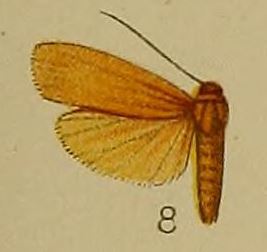Brunia is a genus of tiger moths in the family Erebidae. The genus was described by Moore in 1878.
Mantala is a monotypic moth genus in the subfamily Arctiinae. Its single species, Mantala tineoides, is found on Borneo. Both the genus and the species were first described by Francis Walker in 1862. The habitat consists of lowland and lower montane forests.
Trichaetoides is a genus of moths in the family Erebidae erected by Jeremy Daniel Holloway in 1988.
Hiaspis is a genus of moths of the family Erebidae.

Penicillifera apicalis is a moth of the family Bombycidae first described by Francis Walker in 1862. It is found from the north-eastern parts of the Himalaya to Sundaland and the Philippines.

Brunia antica is a moth of the family Erebidae described by Francis Walker in 1854. It is found from the Indian subregion, Sri Lanka to China, the Ryukyu Islands, the Chagos Archipelago, the Nicobar Islands and Sundaland.

Brunia dorsalis is a species of moth of the family Erebidae. It was described by Francis Walker in 1866. It is found in the Northern Territory, Queensland, the Sula Islands, the Louisiade Archipelago and New Guinea.
Cyclosia pieridoides, the False Idea Moth, is a moth in the family Zygaenidae. It was described by Francis Walker in 1862. It is found in Asia.
Brunia badrana is a moth of the family Erebidae. It was described by Moore in 1859. It is found on Java and Bali.
Brunia nebulifera is a moth of the family Erebidae. It was described by George Hampson in 1900. It is found on Borneo and in Singapore. The habitat consists of lowland forests, including lowland dipterocarp forests, mangroves and disturbed areas.
Brunia sarawaca is a moth of the family Erebidae. It was described by Arthur Gardiner Butler in 1877. It is found on Borneo, Peninsular Malaysia, Java and the north-eastern Himalayas. The habitat consists of lowland forests.
Ovenna vicaria, the ubiquitous footman, is a moth of the subfamily Arctiinae. It was described by Francis Walker in 1854. It is found in Africa, where it has been recorded from Angola, Cameroon, the Republic of the Congo, the Democratic Republic of the Congo, Guinea, Lesotho, Malawi, Mozambique, Nigeria, South Africa, Uganda and Zambia. Records from the Oriental region refer to Brunia antica.

Eugoa trifascia is a lichen moth in the family Erebidae, subfamily Arctiinae. The species was first described by Francis Walker in 1862. It is found on Peninsular Malaysia and Borneo. The habitat consists of lowland to lower montane forests.
Eugoa turbida is a moth of the family Erebidae first described by Francis Walker in 1862. It is found on Borneo. The habitat consists of lowland forests.
Teulisna chiloides is a moth in the family Erebidae. It was described by Francis Walker in 1862. It is found on Peninsular Malaysia, Sumatra, Borneo, Sulawesi and Sumbawa. It has also been recorded from Queensland, Australia. The habitat consists of lowland dipterocarp forests, alluvial forests and lower montane forests.
Trichaetoides apicalis is a moth in the family Erebidae. It was described by Francis Walker in 1856. It is found on Sumatra and Borneo.
Bembina apicalis is a moth of the family Erebidae first described by Francis Walker in 1865. It is found in India and Sri Lanka.
Callopistria apicalis is a moth of the family Noctuidae first described by Francis Walker in 1855. It is found in the Indian subregion, Sri Lanka, Sundaland and the Philippines.


